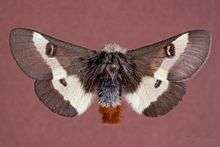Buck moth
The buck moth (Hemileuca maia)[1] is a common insect found in oak forests, stretching in the United States from peninsular Florida to New England, and as far west as Texas and Kansas. It was first described by Dru Drury in 1773.[2] The larvae typically emerge in a single generation in the spring. The larvae are covered in hollow spines that are attached to a poison sac. The poison can cause symptoms ranging from stinging, itching and burning sensations to nausea.[3] Subspecies Hemileuca maia maia is listed as endangered in the US state of Connecticut.[4]
| Buck moth | |
|---|---|
 | |
| Male | |
| Scientific classification | |
| Kingdom: | |
| Phylum: | |
| Class: | |
| Order: | |
| Family: | |
| Genus: | |
| Species: | H. maia |
| Binomial name | |
| Hemileuca maia Drury, 1773 | |
The larvae feed on various oaks including scrub oak (Quercus ilicifolia), live oak (Quercus virginiana), blackjack oak (Quercus marilandica), white oak (Quercus alba), and dwarf chinquapin oak (Quercus prinoides).[5]
Eggs are typically laid in spiral clusters on oak twigs.[6] Mature larvae enter the soil or leaf litter to pupate in late July and emerge between October and the following February as moths to mate and lay eggs. In Louisiana, particularly in cities such as Baton Rouge or New Orleans, where use of live oaks as street trees is extensive, the caterpillars can become a significant nuisance for humans.[7] The caterpillars of this moth can also be a nuisance in some areas of Virginia, such as the Goshen Scout Reservation, where they are infamous for stinging people going to a summer camp in the area.
Taxonomy
The buck moth is in family Saturniidae and genus Hemileuca. There are currently 34 known species in genus Hemileuca. Due to similarities in larval characteristics, adult phenotype and food sources, several groups have been formed within the genus. H. maia is member of the maia group of genus Hemileuca.
There are eleven species in the Hemileuca maia species complex and four subspecies of H. maia:[8]
- Hemileuca maia (Drury, 1773)
*Hemileuca maia maia (Drury, 1773) *Hemileuca maia sandra Pavulaan, 2020 *Hemileuca maia warreni Pavulaan, 2020 *Hemileuca maia orleans Pavulaan, 2020 *Hemileuca maia menyanthevora Pavulaan, 2020
- Hemileuca grotei Grote & Robinson, 1868
- Hemileuca nevadensis Stretch, 1872
- Hemileuca juno Packard, 1872
- Hemileuca diana Packard, 1874
- Hemileuca lucina H. Edwards, 1887
- Hemileuca artemis Packard, 1893
- Hemileuca slosseri Peigler & Stone, 1989
- Hemileuca peigleri Lemaire, 1981
- Hemileuca artemis Packard, 1893
- Hemileuca iroquois Cryan & Dirig, 2020
Hemileuca maia menyanthevora was originally described as a subspecies of Hemileuca maia on April 1, 2020[9]. Cryan & Dirig (2020)[10] described the same taxon as species Hemileuca iroquois on April 2nd, 2020. The names have not yet been formally synonymized in a publication, nor has the status (species/subspecies) of either name been changed.
References
- Beccaloni, G.; Scoble, M.; Kitching, I.; Simonsen, T.; Robinson, G.; Pitkin, B.; Hine, A.; Lyal, C., eds. (2003). "Hemileuca maia". The Global Lepidoptera Names Index. Natural History Museum. Retrieved April 27, 2018.
- Bartlett, Troy (October 24, 2015). "Species Hemileuca maia - Buck Moth - Hodges#7730". BugGuide.Net. Retrieved April 27, 2018.
- "Stinging Caterpillars". University of Kentucky. Archived from the original on September 27, 2011. Retrieved October 18, 2011.
- "Connecticut's Endangered, Threatened and Special Concern Species 2015". State of Connecticut Department of Energy and Environmental Protection Bureau of Natural Resources. Retrieved January 19, 2018.
- Eastern buckmoth Hemileuca maia (Drury, 1773). Butterflies and Moths of North America. Retrieved April 27, 2018.
- "Buck Moth". Entomology and Plant Pathology. Auburn University College of Agriculture. Retrieved April 27, 2018.
- "Louisiana Insect Pest 2012 Management Guide" (PDF). 2012.
- Tuskes, Paul; Tuttles, James; Collins, Michael (1996). The Wild Silk Moths of North America: A Natural History of the Saturniidae of the United States and Canada. Cornell University Press. ISBN 0801431301.
- Pavulaan, Harry (April 1, 2020). "A phenotypic comparison of regional populations of Hemileuca maia (Drury, 1773) with designations of new subspecies (Bombycoidea, Saturniidae, Hemileucinae)". Taxonomic report of the International Lepidoptera Survey. 8: 1–16.
- Cryan, John F.; Dirig, Robert. "Moths of the past: Eastern North American Buck Moths (Hemileuca, Saturniidae), with notes on their origin, evolution, and biogeography". Pine Bush Historic Preservation Project Occasional Publication. 2: 1–44.
External links